设计模式FacedeStructure标签03标签04标签05
说明:
- 外观模式
- 结构型模式
视频
动机(Motivate):
在软件开发系统中,客户程序经常会与复杂系统的内部子系统之间产生耦合,而导致客户程序随着子系统的变化而变化。那么如何简化客户程序与子系统之间的交互接口?如何将复杂系统的内部子系统与客户程序之间的依赖解耦?
意图(Intent):
为子系统中的一组接口提供一个一致的界面,Facade模式定义了一个高层接口,这个接口使得这一子系统更加容易使用。《设计模式》GOF
结构图(Struct):
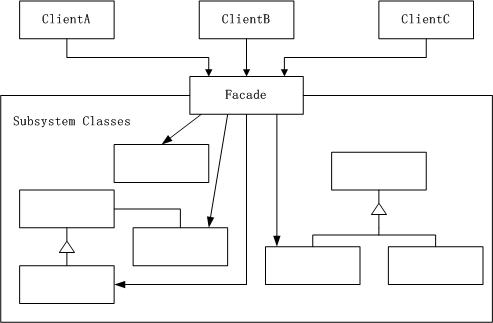
适用性:
- 为一个复杂子系统提供一个简单接口。
- 提高子系统的独立性。
在层次化结构中,可以使用Facade模式定义系统中每一层的入口。
生活中的例子:
代码实现:
我们平时的开发中其实已经不知不觉的在用Façade模式,现在来考虑这样一个抵押系统,当有一个客户来时,有如下几件事情需要确认:到银行子系统查询他是否有足够多的存款,到信用子系统查询他是否有良好的信用,到贷款子系统查询他有无贷款劣迹。只有这三个子系统都通过时才可进行抵押。我们先不考虑Façade模式,那么客户程序就要直接访问这些子系统,分别进行判断。类结构图下:
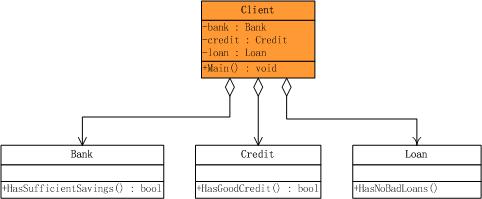
在这个程序中,我们首先要有一个顾客类,它是一个纯数据类,并无任何操作,示意代码://顾客类public class Customer{private string _name;public Customer(string name){this._name = name;}public string Name{get { return _name; }}}
下面这三个类均是子系统类,示意代码: ```csharp //银行子系统 public class Bank { public bool HasSufficientSavings(Customer c, int amount) {
Console.WriteLine("Check bank for " + c.Name);return true;
} }
//信用子系统 public class Credit { public bool HasGoodCredit(Customer c) { Console.WriteLine(“Check credit for “ + c.Name); return true; } }
//贷款子系统 public class Loan { public bool HasNoBadLoans(Customer c) { Console.WriteLine(“Check loans for “ + c.Name); return true; } }
看客户程序的调用:```csharp//客户程序public class MainApp{private const int _amount = 12000;public static void Main(){Bank bank = new Bank();Loan loan = new Loan();Credit credit = new Credit();Customer customer = new Customer("Ann McKinsey");bool eligible = true;if (!bank.HasSufficientSavings(customer, _amount)){eligible = false;}else if (!loan.HasNoBadLoans(customer)){eligible = false;}else if (!credit.HasGoodCredit(customer)){eligible = false;}Console.WriteLine("\n" + customer.Name + " has been " + (eligible ? "Approved" : "Rejected"));Console.ReadLine();}}
可以看到,在不用Façade模式的情况下,客户程序与三个子系统都发生了耦合,这种耦合使得客户程序依赖于子系统,当子系统化时,客户程序也将面临很多变化的挑战。一个合情合理的设计就是为这些子系统创建一个统一的接口,这个接口简化了客户程序的判断操作。看一下引入Façade模式后的类结构图: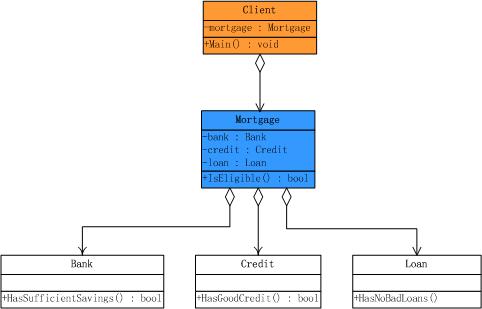
变外观类Mortage的实现如下:
//外观类public class Mortgage{private Bank bank = new Bank();private Loan loan = new Loan();private Credit credit = new Credit();public bool IsEligible(Customer cust, int amount){Console.WriteLine("{0} applies for {1:C} loan\n",cust.Name, amount);bool eligible = true;if (!bank.HasSufficientSavings(cust, amount)){eligible = false;}else if (!loan.HasNoBadLoans(cust)){eligible = false;}else if (!credit.HasGoodCredit(cust)){eligible = false;}return eligible;}}
顾客类和子系统类的实现仍然如下:
//银行子系统public class Bank{public bool HasSufficientSavings(Customer c, int amount){Console.WriteLine("Check bank for " + c.Name);return true;}}//信用证子系统public class Credit{public bool HasGoodCredit(Customer c){Console.WriteLine("Check credit for " + c.Name);return true;}}//贷款子系统public class Loan{public bool HasNoBadLoans(Customer c){Console.WriteLine("Check loans for " + c.Name);return true;}}//顾客类public class Customer{private string name;public Customer(string name){this.name = name;}public string Name{get { return name; }}}
而此时客户程序的实现:
//客户程序类public class MainApp{public static void Main(){//外观Mortgage mortgage = new Mortgage();Customer customer = new Customer("Ann McKinsey");bool eligable = mortgage.IsEligible(customer, 125000);Console.WriteLine("\n" + customer.Name +" has been " + (eligable ? "Approved" : "Rejected"));Console.ReadLine();}}
可以看到引入Façade模式后,客户程序只与Mortgage发生依赖,也就是Mortgage屏蔽了子系统之间的复杂的操作,达到了解耦内部子系统与客户程序之间的依赖。
.NET架构中的Façade模式
Façade模式在实际开发中最多的运用当属开发N层架构的应用程序了,一个典型的N层结构如下:
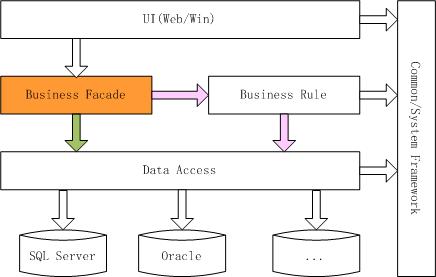
在这个架构中,总共分为四个逻辑层,分别为:用户层UI,业务外观层Business Façade,业务规则层Business Rule,数据访问层Data Access。其中Business Façade层的职责如下:<br />l 从“用户”层接收用户输入<br />l 如果请求需要对数据进行只读访问,则可能使用“数据访问”层<br />l 将请求传递到“业务规则”层<br />l 将响应从“业务规则”层返回到“用户”层<br />l 在对“业务规则”层的调用之间维护临时状态<br />对这一架构最好的体现就是Duwamish示 例了。在该应用程序中,有部分操作只是简单的从数据库根据条件提取数据,不需要经过任何处理,而直接将数据显示到网页上,比如查询某类别的图书列表。而另 外一些操作,比如计算定单中图书的总价并根据顾客的级别计算回扣等等,这部分往往有许多不同的功能的类,操作起来也比较复杂。如果采用传统的三层结构,这 些商业逻辑一般是会放在中间层,那么对内部的这些大量种类繁多,使用方法也各异的不同的类的调用任务,就完全落到了表示层。这样势必会增加表示层的代码 量,将表示层的任务复杂化,和表示层只负责接受用户的输入并返回结果的任务不太相称,并增加了层与层之间的耦合程度。于是就引入了一个Façade层,让这个Facade来负责管理系统内部类的调用,并为表示层提供了一个单一而简单的接口。看一下Duwamish结构图: <br />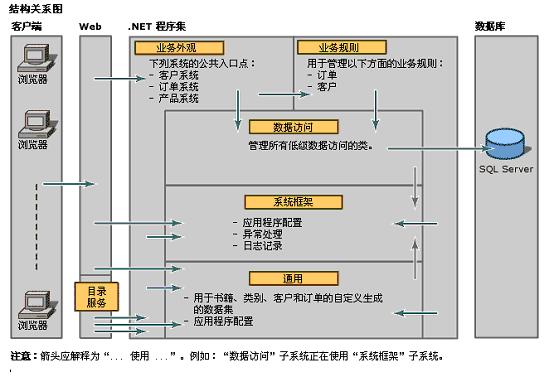<br />从图中可以看到,UI层将请求发送给业务外观层,业务外观层对请求进行初步的处理,判断是否需要调用业务规则层,还是直接调用数据访问层获取数据。最后由数据访问层访问数据库并按照来时的步骤返回结果到UI层,来看具体的代码实现。<br />在获取商品目录的时候,Web UI调用业务外观层:
productSystem = new ProductSystem();categorySet = productSystem.GetCategories(categoryID);
业务外观层直接调用了数据访问层:
public CategoryData GetCategories(int categoryId){//// Check preconditions//ApplicationAssert.CheckCondition(categoryId >= 0,"Invalid Category Id",ApplicationAssert.LineNumber);//// Retrieve the data//using (Categories accessCategories = new Categories()){return accessCategories.GetCategories(categoryId);}}
在添加订单时,UI调用业务外观层:
public void AddOrder(){ApplicationAssert.CheckCondition(cartOrderData != null, "Order requires data", ApplicationAssert.LineNumber);//Write trace log.ApplicationLog.WriteTrace("Duwamish7.Web.Cart.AddOrder:\r\nCustomerId: " +cartOrderData.Tables[OrderData.CUSTOMER_TABLE].Rows[0][OrderData.PKID_FIELD].ToString());cartOrderData = (new OrderSystem()).AddOrder(cartOrderData);}//业务外观层调用业务规则层:public OrderData AddOrder(OrderData order){//// Check preconditions//ApplicationAssert.CheckCondition(order != null, "Order is required", ApplicationAssert.LineNumber);(new BusinessRules.Order()).InsertOrder(order);return order;}//业务规则层进行复杂的逻辑处理后,再调用数据访问层:public OrderData AddOrder(OrderData order){//// Check preconditions//ApplicationAssert.CheckCondition(order != null, "Order is required", ApplicationAssert.LineNumber);(new BusinessRules.Order()).InsertOrder(order);return order;}//业务规则层进行复杂的逻辑处理后,再调用数据访问层:public bool InsertOrder(OrderData order){//// Assume it's good//bool isValid = true;//// Validate order summary//DataRow summaryRow = order.Tables[OrderData.ORDER_SUMMARY_TABLE].Rows[0];summaryRow.ClearErrors();if (CalculateShipping(order) != (Decimal)(summaryRow[OrderData.SHIPPING_HANDLING_FIELD])){summaryRow.SetColumnError(OrderData.SHIPPING_HANDLING_FIELD, OrderData.INVALID_FIELD);isValid = false;}if (CalculateTax(order) != (Decimal)(summaryRow[OrderData.TAX_FIELD])){summaryRow.SetColumnError(OrderData.TAX_FIELD, OrderData.INVALID_FIELD);isValid = false;}//// Validate shipping info//isValid &= IsValidField(order, OrderData.SHIPPING_ADDRESS_TABLE, OrderData.SHIP_TO_NAME_FIELD, 40);//// Validate payment info//DataRow paymentRow = order.Tables[OrderData.PAYMENT_TABLE].Rows[0];paymentRow.ClearErrors();isValid &= IsValidField(paymentRow, OrderData.CREDIT_CARD_TYPE_FIELD, 40);isValid &= IsValidField(paymentRow, OrderData.CREDIT_CARD_NUMBER_FIELD, 32);isValid &= IsValidField(paymentRow, OrderData.EXPIRATION_DATE_FIELD, 30);isValid &= IsValidField(paymentRow, OrderData.NAME_ON_CARD_FIELD, 40);isValid &= IsValidField(paymentRow, OrderData.BILLING_ADDRESS_FIELD, 255);//// Validate the order items and recalculate the subtotal//DataRowCollection itemRows = order.Tables[OrderData.ORDER_ITEMS_TABLE].Rows;Decimal subTotal = 0;foreach (DataRow itemRow in itemRows){itemRow.ClearErrors();subTotal += (Decimal)(itemRow[OrderData.EXTENDED_FIELD]);if ((Decimal)(itemRow[OrderData.PRICE_FIELD]) <= 0){itemRow.SetColumnError(OrderData.PRICE_FIELD, OrderData.INVALID_FIELD);isValid = false;}if ((short)(itemRow[OrderData.QUANTITY_FIELD]) <= 0){itemRow.SetColumnError(OrderData.QUANTITY_FIELD, OrderData.INVALID_FIELD);isValid = false;}}//// Verify the subtotal//if (subTotal != (Decimal)(summaryRow[OrderData.SUB_TOTAL_FIELD])){summaryRow.SetColumnError(OrderData.SUB_TOTAL_FIELD, OrderData.INVALID_FIELD);isValid = false;}if ( isValid ){using (DataAccess.Orders ordersDataAccess = new DataAccess.Orders()){return (ordersDataAccess.InsertOrderDetail(order)) > 0;}}elsereturn false;}
Facade模式的个要点:
从客户程序的角度来看,Facade模式不仅简化了整个组件系统的接口,同时对于组件内部与外部客户程序来说,从某种程度上也达到了一种“解耦”的效果----内部子系统的任何变化不会影响到Facade接口的变化。<br /> Facade设计模式更注重从架构的层次去看整个系统,而不是单个类的层次。Facdae很多时候更是一种架构
设计模式。
注意区分Facade模式、Adapter模式、Bridge模式与Decorator模式。Facade模式注重简化接口,Adapter模式注重转换接口,Bridge模式注重分离接口(抽象)与其实现,Decorator模式注重稳定接口的前提下为对象扩展功能。
- 本文作者:GeekPower - Felix Sun
- 版权声明: 本博客所有文章除特别声明外,均采用 MIT 许可协议。转载请注明出处!


